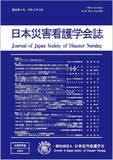Japanese
English
- 有料閲覧
- Abstract 文献概要
- 参考文献 Reference
要 旨
【目的】本研究の目的は,インドネシア大学災害看護研究チームが『健康のための災害リスク管理』の看護基準の作成過程で抽出した指標が,東日本大震災における看護実践にも適用できるかどうかを検討することである.
【方法】日本看護協会が出版した「ナース発東日本大震災レポート」(2011)に収録されている117ファイルのうち,災害リスク管理に関わる看護実践が具体的に記述されている111ファイルを分析対象として,看護実践の抽出およびカテゴリー化した.
【結果】抽出された看護実践は496件であり,55のカテゴリーが抽出された.このうち約9割がインドネシア版災害リスク管理指標に該当していた.また,指標に該当しなかったカテゴリーは<死者および遺族へのケア>と<ケア提供者へのケア>であった.
【結論】両国に特有な看護実践はあるものの,概ね『健康のための災害リスク管理』の指標に該当しており,本指標は日本においても適用可能であることが示唆された.
Purpose
The purpose of this study is to examine the applicability of indicators in regard to the development of a nursing standard for health-related disaster risk management by the Disaster Nursing Research Team of the University of Indonesia, based on the nursing practices prevalent during the Great East Japan Earthquake.
Methods
This is a qualitative study that uses a total of 111 files that describe nursing practices related to disaster risk management contained in the nurses' activity record titled, “Report on the Great East Japan Earthquake by Nurses” published in 2011 by the Japan Nursing Association.
Results
Four hundred and ninety-six items corresponding to nursing practices related to disaster risk management were found. Approximately 90% of these are parallel to the indicators developed in Indonesia, thus proving the indicators' applicability. The categories of “care for the deceased and bereaved” and “care for care providers” were identified as nursing practices that did not have parallel indicators.
Copyright © 2020, Japan Society of Disaster Nursing All rights reserved.


